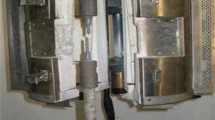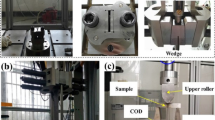Abstract
In collision accidents, ductile fracture may occur in base metal or weld metal without evident defects. We propose a test method for evaluating the initiation and growth behavior of internal ductile cracks in metals, particularly in high-strength steel materials. In previous studies, the internal ductile crack initiation behaviors in steel were evaluated considering the effect of stress triaxiality on the critical equivalent plastic strain using some round bar specimens, where each specimen had a different circumferential notch in size. However, it is difficult to observe a transition process from crack initiation to growth and measure crack driving force parameters in high-strength steels, because ductile cracks grow abruptly soon after their initiation. Accordingly, to investigate the ductile crack initiation and growth behavior, we developed two stress triaxiality–controlled specimens with a mechanism to decelerate the propagation rate of ductile cracks. The applicability of these specimens to the evaluation of ductile crack initiation condition was discussed based on the results of tensile fracture tests used on three types of steels and one weld metal and finite element analyses. The ductile crack initiation limits of the weld metal widely varied compared to the base metal and were comparable to or significantly lower than those of the base metals in this study.















Similar content being viewed by others
References
Saito K (2014) The current application situation of high-tensile strength steel sheet for automotive body. Materia Japan 12(53):584–588
Kuriyama Y et al (2013) WorldAutoSteel Program: future steel vehicle (first report)-design concept and main results. Trans Soc Automot Eng Japan 44(2):511–516
Chinzei S, Naito J (2017) Simulation to predict failure in high-strength steel sheet. Kobe Steel Eng Rep 66(2):76–81
Yasuaki T et al (2012) Effect of cross sectional shape and material properties on impact deformation behavior of ultra high strength steel members. Transactions of the Japan Society of Mechanical Engineers Series A 791(78):955–965
Park SJ et al (2021) Comparative study on ductile fracture prediction of high-tensile strength marine structural steels. Ships Offshore Struct 15:208–209
Glykas A et al (2001) Application of failure and fracture criteria during a tanker head-on collision. Ocean Eng 28:375–395
Ichikawa K et al (2018) Improvement of crashworthiness of oil tankers with high strength and highly ductile steels. Materia Japan 1(57):14–16
Okawa T et al (2016) On the application of highly ductile steel on ship structures to mitigate damage due to ship collision (Part 1) development of highly ductile steel for shipbuilding. Conf Proc Japan Soc Naval Architects Ocean Eng 22:553–555
Rice JR, Tracy DM (1969) On the ductile enlargement of voids in triaxial stress fields. J Mech Phys Solids 17(3):201–217
Bridgman PW (1952) Studies in large flow and fracture with special emphasis on the effects of hydrostatic pressure. Harvard University Press, Cambridge
Ishiguro T et al (2013) Influence of stress triaxiality and microstructural anisotropy on ductile behavior of medium-carbon steel. J JSTP 54(634):993–997
Yamada T et al (2018) A study on the effect of material properties on the characteristics of ductile crack initiation limit. Q J Japan Weld Soc 36(4):284–292
Ueda H et al (2013) Study of the fracture prediction of spot welded joint using local plastic strain and stress triaxiality as fracture criterion (First Report) development of FE analysis model for fracture prediction. Trans Soc Automot Eng Japan 44(2):727–732
Mutoh Y et al (1985) Ductile fracture in type 304 stainless steel weldments. Quarterly J Japan Weld Soc 3(4):869–874
Borja E et al (2018) Stress-state and strain-rate dependent ductile fracture of dual and complex phase steel. Mech Mater 116:11–32
Yuanli B et al (2008) A new model of metal plasticity and fracture with pressure and Lode dependence. Int J Plast 24(6):1071–1096
Hiramatsu H et al (2002) Ductile crack initiation behavior of structural materials under low stress triaxiality. J Soc Naval Architects Japan 192:563–571
Shimanuki H et al (1995) Effect of stress triaxiality and strain rate on ductile fracture initiation in steel. J Soc Naval Architects Japan 186:475–483
Swift HW (1952) Plastic instability under plane stress. J Mech Phys Solid 1:1–18
Hancock JW et al (1976) On the mechanisms of ductile failure in high-strength steel subjected to multi-axial stress-states. J Mech Phys Solid 24:147–169
Author information
Authors and Affiliations
Corresponding author
Ethics declarations
Conflict of interest
The authors declare no competing interests.
Additional information
Publisher's note
Springer Nature remains neutral with regard to jurisdictional claims in published maps and institutional affiliations.
Recommended for publication by Commission X - Structural Performances of Welded Joints - Fracture Avoidance.
Rights and permissions
Springer Nature or its licensor (e.g. a society or other partner) holds exclusive rights to this article under a publishing agreement with the author(s) or other rightsholder(s); author self-archiving of the accepted manuscript version of this article is solely governed by the terms of such publishing agreement and applicable law.
About this article
Cite this article
Hatamoto, A., Shimanuki, H. Method for evaluating the ductile fracture properties of steel parent material and weld metal. Weld World 67, 1595–1605 (2023). https://doi.org/10.1007/s40194-023-01512-8
Received:
Accepted:
Published:
Issue Date:
DOI: https://doi.org/10.1007/s40194-023-01512-8




